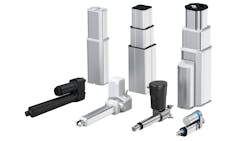Are you considering electromechanical actuators for industrial applications? Check out our Difference Between: High Duty and Low Duty Electromechanical Actuators to determine how to choose the right product for your application. In it, you'll learn:
- The differences between pneumatic and hydraulic cylinders and electromechanical actuators, including how electromechanical actuators can simplify maintenance, improve safety, and reduce energy usage over the equipment's lifetime.
- When to use high duty versus low duty electromechanical actuators based on load capacity, speed of motion, precision, and expected duty cycle.
- The variety of industrial applications that are well-suited to electromechanical actuators, including those requiring rugged construction for harsh environments.
- How to implement smart controls in electromechanical actuators and streamline conversion from fluid power cylinders with drop-in replacements.
Download our Difference Between: High Duty and Low Duty Electromechanical Actuators to learn more about the details to consider when converting to electromechanical actuators.

